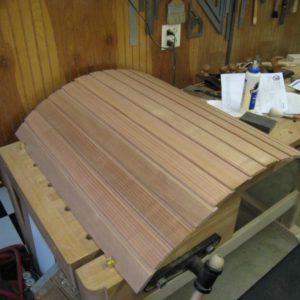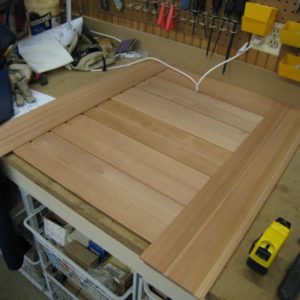What is the Best Finish for Exterior Redwood?

I’m replacing the skirt and steps on our hot tub. As I’ve put in a lot of work resawing, ripping and routering the wood from stock clear heart redwood. I wanted to preserve the natural look as much as possible. I’ve heard Penofin oil is a good choice for a clear finish though I’m not sure it has mildewcides and it’s a little hard to find around here. The old skirt saw little rotting but the steps were another story. Wherever the wood pieces were screwed together, rot was evident.
So I’m thinking of thoroughly gluing the step pieces together with waterproof glue then sealing them with a clear coat that has a mildewcide. I realize that by gluing the step parts together, replacing those parts will be very difficult. But the old steps lasted almost 18 years. By then I may not even be around. So I’m okay with that.
Mostly I wanted to enhnace the wood’s beauty while protecting it from the weather and other damaging factors. Annual recoating is fine with me.
Any suggestions?
Thanks,
Julie
PS: I’m attaching some pics of what I’ve done so far





















Replies
Are you sure it was rot, and not just tannins reacting with the fastener coating?
For the stairs I would look at back fastening using pocket screws or Simpson brackets.
At all points where one piece of wood was in contact with another there was dirt and high moisture conditions. Some of the wood turned spongy. You can crush it with thumb pressure. The manufacturer only used galvanized screws to secure the pieces together - no glue or sealant. The rot was found in areas where two or more pieces were secured together and was less prone to drying out.
All of the screws were back fastened and galvanized. Very little of the rot was found around the screws. Moisture was the common element in all the rot I found.
Usually
The end cuts of wood left unsealed and in a place where they will wick up moisture, expand, wick, expand.........several dryouts in between, and many more wick expands till the lignins..........or whatever all those old capillaries are called, move no more. That's when the rot starts and continues.
Seal the ends, or use very old growth wood and you might have a chance.
Yeah, seal the cut ends (very well!) before you put it together, and you'll cover 90% of the problem. I wouldn't use glue. Try for the absolute minimum "dimple" when setting the screws, so they don't hold water.